
Holy Week is one of the most popular festivities in Spain. The religious tradition inherited from centuries ago has made an impression on the population and during Maundy Thursday and Good Friday, as well as on Easter Sunday, a great number of parades, processions and masses take place in Spain. However, it should not be forgotten that within each of the different regions, a tradition has been developed that makes it unique. These different ways of experiencing this tradition are the main topics of this article. These are some of the best regions of Spain for this Holy Week and how they celebrate it.
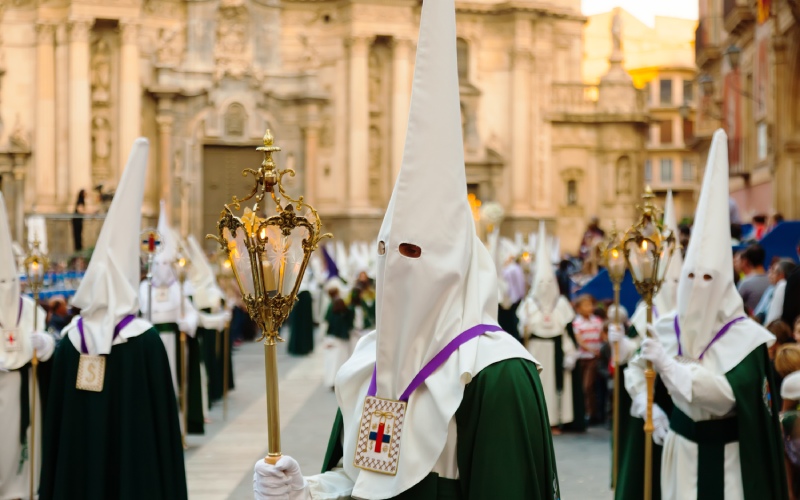
Nazarenes in Murcia. | Shutterstock
Murcia is one of the regions that most intensively celebrate the Holy Week. There are many different processions which stand out for their neatness and solemnity. One of the most relevant is ‘El Silencio de los Jueves’, which takes place in the city of Murcia and all the Nazarenes follow it in complete silence. Besides, it is worth mentioning the procession on Good Friday in Salzillo, known as ‘procesión del beso’ (“kiss procession”) since it is celebrated when the first rays of sunlight bounce off the banner.
However, not everything in these festivities is solemnity and serious faces. Murcia has one of the most cheerful customs of Holy Week since all the Nazarenes carry a large pocket in their tunic full of sweets which they hand out to the children who come to see them in the processions. As a result, they attract people of all ages and give it a more joyful aspect, while respecting these days.
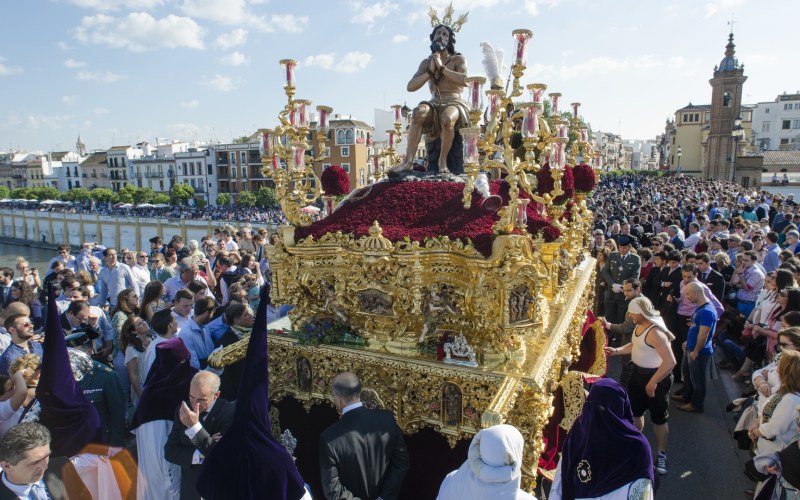
Procession in Seville | Shutterstock
The other great region that every year celebrates with high-relevance the Holy Week is Andalusia. The whole region lives these days very intensely, but there are two particular cities that get the lion’s share of the limelight. Seville and Malaga get most of the attention for their impressive processions and for the sentiment that they give off among the believers who come to honour them.
Seville is crowned as one of the cities where Holy Week is experienced with the greatest feeling, thanks to their more than 60 brotherhoods. For that reason, this festivity has been declared of International Tourist Interest. Its two most important processions are the ‘Gran Poder’ and ‘La Madrugá’, both of which take place on Good Friday and are followed by more than 2,400 Nazarenes.
Malaga also stand out for this festivity, as not only does it celebrate several important processions that carry huge thrones with the religious figures, but it is also the city in charge of organising the procession of the Spanish Legion, called the ‘Cristo de la Buena Muerte’ (Christ of the Good Death).
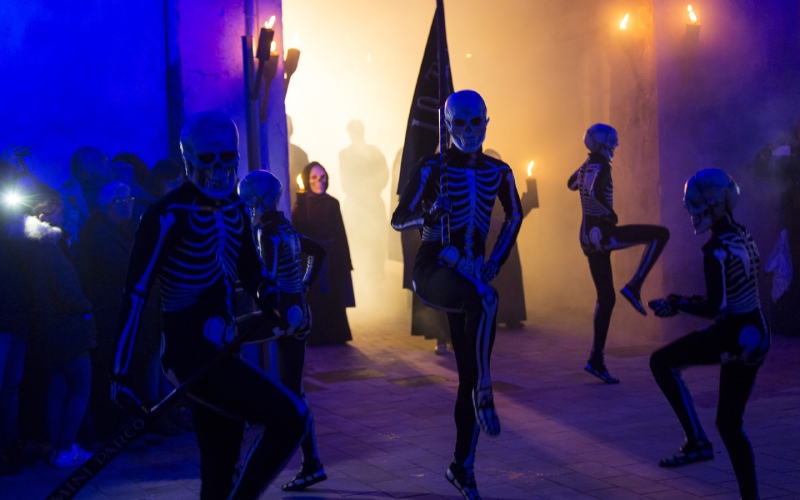
Dance of the Dead in Catalonia | Shutterstock
Catalonia is a region with relevant cultural traditions which have a significant character and distinctive feature. Its Holy week is a clear example. Despite carrying out the more traditional processions as in the rest of the country, there is an event that takes place on Maundy Thursday that has become a tourist attraction.
It is called ‘La Danza de los Muertos’ (“Dance of the Dead”) and is held in Girona, specifically in Verges. At night, a group of 10 people in skeleton costumes dance and let their shadows reflect on the walls of the medieval town. It is said to be a remembrance of the Black Death and of the Christian hope that lies above all the deaths it left behind.
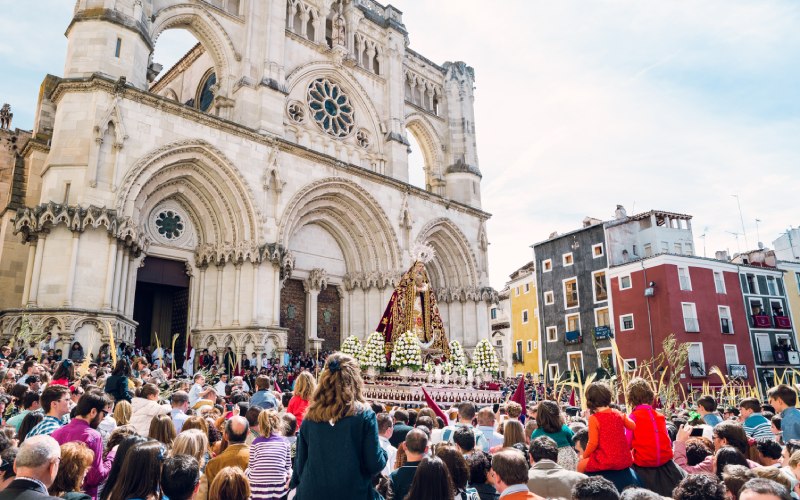
Procession in Cuenca | Shutterstock
Castilla La Mancha is a region within Spain with a great traditional atmosphere and fairy-tale towns with a medieval past, for example Cuenca. With such a setting, the Holy Week processions are guaranteed to impress any tourist who visits the region. In fact, the believers who attend all the processions that take place throughout the region do so in an austere and heartfelt way.
There are several traditions within Castilla-La Mancha that have stood out and become popular throughout the country and one of them is La ‘Procesión de los Borrachos’ (“Procession of the Drunks”), also called the ‘Procesión del Camino del Calvario’ (Procession of the Road to Calvary). The participants play the role of the mob that “mocked” Jesus on his way to the cross. They do this every Good Friday morning with shouts and drum beats, but always respecting the tradition.
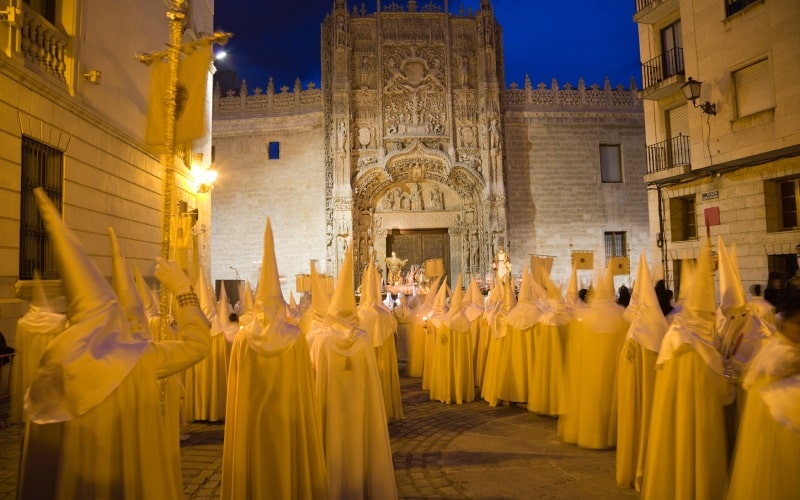
Procession in Valladolid | Shutterstock
Holy Week in Castilla y León includes some of the oldest processions in the whole country. However, there is also always some funny traditions during these religious festivities, and a clear example would be the procession of ‘San Genarín de León’, one of the few pagan processions that take place during Holy Week in Spain.
This tradition is relatively new compared to the others, dating back to the beginning of the 20th century. It has its origins in the Father Genarín, an ecclesiastic who was not very strict with Christian norms. His death, caused by a rubbish lorry, became a source of legend among his colleagues and since then he was honoured on Maundy Thursday. It is not a procession that is very popular with the religious community, as it sometimes even coincides with the official and traditional processions, which in Castilla y León are celebrated with great solemnity. But it is undoubtedly an event worth visiting from a relaxed point of view. Especially when the procession ends by offering fruit and orujo (grape marc) on the wall where he is tributed.
You can also read this article in Spanish and French.
Follow us on Facebook!